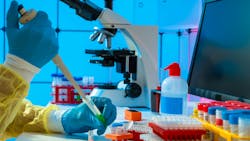DOE invests $25 million to recover critical minerals from U.S. wastewater
The U.S. Department of Energy’s Advanced Research Projects Agency–Energy (ARPA-E) has announced $25 million in funding for 10 projects developing technologies to extract critical minerals and valuable nutrients from wastewater streams.
Funded through the Realize Energy-rich Compound Opportunities Valorizing Extraction from Refuse Waters (RECOVER) program, the initiative supports innovative recovery methods that could strengthen domestic supply chains for key materials used in energy production, electronics, and advanced manufacturing.
“These minerals are called critical for a reason. They enable our nuclear reactors, advanced electronics, and energy storage technologies,” said ARPA-E Director Conner Prochaska in a press release. “RECOVER will join the other initiatives in DOE’s critical minerals campaign to reshore the processing of critical materials and strengthen our domestic supply of these vital resources.”
RECOVER technologies will be compatible with wastewater treatment infrastructure, helping utilities and industries extract valuable materials from waste streams that would otherwise be discarded.
Awarded projects include:
-
Northwestern University (Chicago, IL) – $2,718,183: Developing N-PRIME, a microbial process that uses self-replicating bacteria to recover nitrogen and phosphorus from municipal wastewater as high-value fertilizers and amino acids.
-
University of Texas at Austin (Austin, TX) – $2,000,000: Creating biomimetic membranes to recover lithium, ammonium, and other critical metal ions from oil and gas produced water and municipal wastewater.
-
Johns Hopkins University (Baltimore, MD) – $2,400,000: Designing a bioacid-mediated electrowinning process to selectively extract cobalt and nickel from industrial wastewater and electronic waste streams.
-
University of Connecticut (Storrs, CT) – $3,000,000: Demonstrating a hybrid ceramic membrane and electrodialysis system to recover more than 90% of phosphorus and ammonia from wastewater as high-value liquid products.
-
Columbia University (New York, NY) – $1,655,334: Using solvent-based processes to recover lithium and magnesium from produced water while reducing waste volumes by more than 99%.
-
University of Missouri (Columbia, MO) – $2,800,000: Employing ion-imprinted polymers enhanced with AI modeling to recover rare earth elements such as neodymium, praseodymium, and terbium from mining waste.
-
Stanford University (Stanford, CA) – $3,000,000: Developing an electrochemical stripping and adsorption process to recover ammonia, phosphorus, and magnesium from anaerobic digestate as market-valuable products.
-
University of California, Davis (Davis, CA) – $3,000,000: Engineering metal-binding proteins to selectively extract rare earth elements from acidic mine-influenced waters using synthetic biology and AI design.
-
Carollo Engineers, Inc. (Costa Mesa, CA) – $2,423,292: Building a biotechnology-driven nanocage system using engineered ferritin proteins to recover metals such as lithium, cobalt, nickel, and dysprosium.
-
Phoenix Tailings, Inc. (Woburn, MA) – $1,600,000: Advancing ligand-enhanced extraction techniques to recover rare earth and critical minerals from industrial brines and wastewater at high selectivity.
Together, these projects could transform wastewater into a resource stream for critical materials—reducing reliance on foreign imports, strengthening U.S. supply chains, and supporting cleaner, more sustainable industrial processes.
